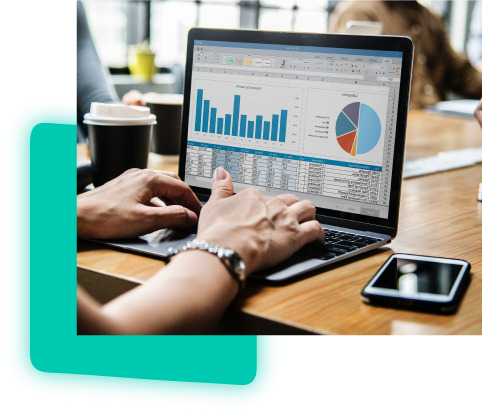401(K)
The 401(k) plan you and your employees deserve.
Saving in a 401(k) is one of the best ways to help achieve your retirement planning goals. Whether you own your business or are employed by someone else, you can learn about 401(k) here, putting you on the right track for a financially independent future.
Get started saving now so you will have the freedom to choose how you want to live when you retire. Since inception, our mission at The 401(k)ompany has been to make it easy for small business owners to design and execute a cost-effective 401(k) saving strategy. Here is our guide to what you need to know about 401(k).

What is a 401(k)?
A 401(k) is a savings vehicle established by a business or self-employed person to help employees and business owners save for retirement as well as take advantage of the tax benefits provided to both the business owner and employees. The flexible features of a 401(k) can accommodate the needs of a broad range of retirement planning objectives. Each individual gets to choose how much of their pay will be deposited into their 401(k) account each pay period – before taxes are deducted and how those dollars will be invested. Many businesses choose to match a portion of the employees’ contributions, helping retirement savings grow even faster.
401(k) benefits
In addition to providing financial well-being in retirement, saving in a 401(k) provides tax advantages for both the business owner and the employees, including tax deductions, tax-deferred earnings, and tax credits. For example, when an employee saves in a 401(k), their contribution is deducted from their paycheck before income taxes are withheld. These pre-tax contributions lower an individual’s tax liability for the year, just for investing in their future.
Roth 401(k)
Many 401(k) plans allow employers and employees to contribute funds to their 401(k) in two ways: as a pre-tax contribution, and as a Roth 401(k) contribution. Roth 401(k) contributions are made with after-tax dollars. When an employee takes money out of their 401(k), those contributions and the investment earnings made are tax-free if the employee meets certain requirements. To qualify for tax-free distributions, the individual must have a Roth 401(k) account for at least 5 years and be 59½ or older, disabled or deceased. Roth 401(k) is a big advantage for those who are concerned about the tax changes that may occur in the future. With a Roth 401(k) , individuals and employers will not be taxed on an uncertain tax future.
Safe Harbor 401(k)
A 401(k) must pass certain nondiscrimination tests each year that are designed to prevent the 401(k) from primarily benefiting high-earning individuals. If a 401(k) fails these tests, an option for the small business owner is to adopt a Safe Harbor 401(k) plan. A Safe Harbor 401(k) can bypass the tests in exchange for specified employer contributions that are fully vested. When an employer chooses a Safe Harbor 401(k), the owners and high-earning individuals will be able to maximize their 401(k) contributions instead of being limited by the amount lower-paid employees contribute to the 401(k).
Employer 401(k) contributions
Many employers make additional contributions to their employees’ 401(k) plan accounts to help their employees reach their retirement planning goals faster, while also taking advantage of additional tax benefits for their business.
The most common employer contribution is a match on a portion of the dollars an employee puts into the plan – for example, an employer may choose to contribute $1 for each dollar the employee contributes, up to the first 3% of the employees’ pre-tax pay. Employers, including self-employed individuals, also sometimes make discretionary profit sharing contributions to their employees.
Maximum 401(k) contributions
For 2019, you can save up to $19,000 of your pay in a 401(k) ($25,000 if you’re age 50 or older). In addition, the business may make matching or profit sharing contributions. Employee contributions, combined with any employer contributions, cannot be greater than the employee’s income for the year, up to a maximum of $56,00 for 2019.
Limits for high-earning individuals
Tax laws require 401(k) plans to pass nondiscrimination tests each year to make certain the 401(k) is not primarily benefiting high-earning individuals within the company. The IRS wants to ensure that plans that are being established within an organization are fair and balanced, hence the name, “nondiscrimination” testing. If lower-paid individuals are not making significant contributions, high-earners and business owners may not be able to maximize their contributions ($19,00 for 2019, $25,000 if age 50 or older).

IRA vs. 401(k)
An Individual Retirement Account or IRA is another type of retirement savings vehicle. IRAs are set up by an individual, usually independent of their employer, and are funded by the individual as an additional way to save money toward their retirement planning goals. IRAs can also receive rollovers of assets from other retirement savings vehicles like 401(k) plans. A 401(k), on the other hand, is established by a business or self-employed individual. A 401(k) plan can accept both employer and employee contributions. Successful savers can use an IRA plus a 401(k) if their employer offers the 401(k) option.
401(k) Investments
401(k) plans generally offer a broad range of investment options. These options are typically selected by the business that sponsors the 401(k). Most 401(k) plans allow employees to choose their own investments from what the business owner (also known as the plan sponsor) selected for the 401(k). Some 401(k)plans provide investment and advisory services to employees. Understanding the risk versus return of the investment fund is important.
Contribution deadlines
Employees who save in a 401(k) contribute a portion of their pay each pay period. Employers must deposit that pay into employees’ 401(k) accounts as soon as possible after each payroll date. Many employers also fund matching contributions each pay period but have until the business’s tax return due date to make employer matching and profit sharing contributions to the company 401(k).
401(k) Distribution Choices
If an individual dissolves their 401(k) and takes the cash, it’s counted as income that year and taxed because the contributions were not taxed when deposited into the 401(k). You will be taxed for the contribution and all the interest earned unless your 401(k) was set up as a Roth, or after-tax plan. Many individuals choose to roll their 401(k) money directly into an IRA or into a 401(k) offered by their new employer. Professional advice: Look at the investment choices available to you and the fees associated with the plan or IRA before making any moves.
401(k) withdrawal
In saving for retirement, tax laws are designed to discourage savers from taking money out of a 401(k) before they retire. Money can only be taken out of a 401(k) after certain events occur such as leaving employment, disability, and retirement. Many 401(k) plans allow individuals to take a withdrawal before retirement if they are experiencing a financial hardship.Distributions taken before an individual reaches retirement age may be subject to early distribution taxes as well as income taxes.

Required minimum distributions
If someone reaches age 70½ and still has money in their 401(k), they must begin taking a minimum payment each year until the account is depleted.
Some 401(k) plans provide exceptions for older workers who are still employed. When the 401(k) participant dies, the person(s) they named as beneficiary generally must continue taking payments out of the 401(k).
401(k) loans
Sometimes individuals have a financial emergency or need for more money than they have on hand. Most 401(k) plans allow the business owner and employees to take a loan from their 401(k) account and pay back the loan, with interest, through payroll deductions.
Let’s get started
Setting up or converting a 401(k) can be complicated.
The 401(k)ompany gives small business owners access to 401(k) professionals in addition to low flat-fees. Each sales professional has over a decade of experience assisting business owners in 401(k) plan design. Take advantage of this free benefit.
© 2022 The 401(k)ompany, All rights reserved.
Securities and Investment Advisory Services offered through A.G.P. / Alliance Global Partners, Member of FINRA | SIPC, a Registered Investment Adviser. Neither A.G.P nor any of its affiliates provide legal, tax or accounting advice.
Investing always involves risk; no investment is protected against loss. Past performance does not indicate future results. Diversification does not ensure a profit or protect against declining markets. Consider your investment objectives before investing.
The A.I.D. Group is not a registered broker-dealer or investment advisory firm. The A.I.D. Group and AGP are independent and not affiliated entities.
Check the background of our investment professionals on FINRA's BrokerCheck
Business Continuity Planning Summary & Disclosure
Certified Financial Planner Board of Standards, Inc. (CFP Board) owns the CFP® certification mark, the CERTIFIED FINANCIAL PLANNER™ certification mark, and the CFP® certification mark (with plaque design) logo in the United States, which it authorizes use of by individuals who successfully complete CFP Board’s initial and ongoing certification requirements.
The CLU® and ChFC(R) marks are the property of The American College, which reserves sole rights to its use, and is used by permission.
